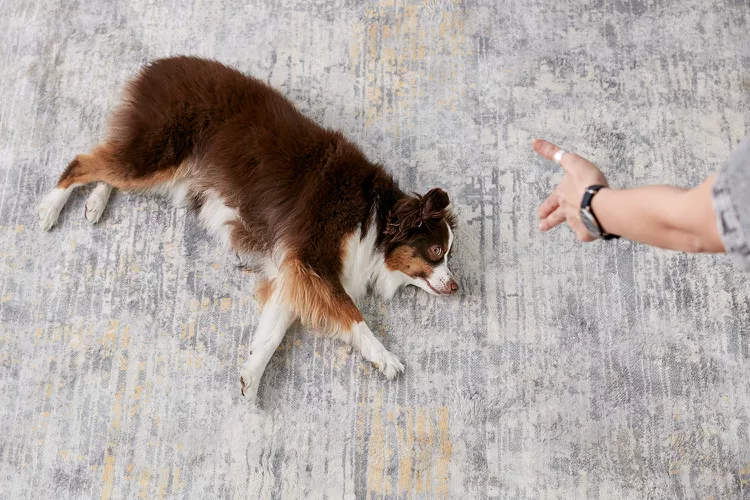
Playing dead is a great dog trick. While it's not as important as teaching your dog to obey commands like "sit" and "stay," it can be a fun game for both the dog and its audience. If your dog knows the "lie down" command, then playing dead should be easy.
All you need is a handful of tasty treats, and you are ready to start training your dog to play dead. This is a great trick to teach by clicker training route, so be sure to have your clicker handy.
If your dog already knows how to roll over, its natural inclination might be to go all the way over when you start to lure it to its side. This is a great time to get your clicker out to capture the exact behavior you want.
If you are having trouble getting your dog to follow the treat so that it ends up lying on its side, you can help by physically moving the dog.
If at any point in the training, your dog makes more than two or three mistakes in a row, you may be moving ahead too quickly. Go back a step or two and practice. When the dog is repeatedly successful at the earlier step, begin the next step.
Remember to be patient and consistent. Each dog is unique and learns at a different pace. Keep training sessions upbeat and stop training if your dog seems frustrated, tired, or bored. Always try to end sessions on a positive and successful note, even if that means switching to a simpler action like "sit" or "down" as the last thing you do.

Finnish Spitz (Finkie): Dog Breed Characteristics & Care
Learn all about Finnish spitz dogs (affectionally nicknamed Finkies), an athletic, friendly breed that makes a great match for active families.
Catahoula Leopard Dog: Breed Characteristics & Care
The Catahoula leopard dog is a devoted working breed that's the state dog of Louisiana. Learn about its history, health, and more.
How to Solve Behavior Problems in Cats
Learn what causes common kitty behavior problems, including chronic licking, aggression, urinary issues, and more, as well as how to solve them.
What to Expect With Your Kitten's First Vet Visit
The first veterinary visit is an important step to making sure your kitten is healthy now and in the future. Find out what you can expect.
7 Amazing Facts About Polydactyl Cats
Polydactyl cats have extra toes on their paws due to a genetic mutation. Learn about the health, history, and cultural influence of polydactyl cats.
How Much Does It Cost to Adopt a Cat?
The cost of adopting a cat or kitten varies depending on whether you go to a shelter, rescue group or breeder.
13 Cats Who Love Christmas
Christmas time is exciting for animals too! Check out these 13 cute cats who love Christmas just as much as us humans.
How Long Should Kittens Stay With Their Mothers?
Kittens need their mothers for more than just milk. Find out how long kittens should stay with their mothers and why.
Can Dogs Eat Kale?
Kale is rich in nutrients, but because it contains compounds that can harm dogs, veterinarians caution against making it a regular part of their diet.
Human Dander Allergies in Dogs
Can a dog really be allergic to humans? Is it common? Learn about dog allergies and what can be done to help them.
Nose Bleeds in Dogs
Nose bleeds can be the sign of a more serious, underlying issue. Learn about what they could be from and what you can do if your dog suffers from one.
Zinc Poisoning in Dogs
Zinc poisoning in dogs is common and can be treated effectively if owners recognize early symptoms after ingestion. Here are a few signs to notice.
Can Cats Have Milk? Why They Really Shouldn’t Drink The Stuff
Despite what we’ve learned from pop culture, cats shouldn’t drink milk as most cats are lactose intolerant. Learn more about feeding milk to cats and alternatives you can feed your cat instead.
Dog Park Etiquette
The dog park can be great, but it's not the place for every dog. Here's what you need to know before bringing your dog to an off-leash dog park.
Why Do Dogs Scratch the Bed?
Your dog's nightly bedtime ritual hearkens back to their wild canine ancestors. Learn about why they do it and when it could be a problem.
Training Deaf Puppies and Dogs
Learn about deaf puppies, what causes deafness in dogs, and how to train a deaf puppy in this article.
What To Do If Your Cat Swallows a String
As a cat caregiver, you need to be aware of the dangers of string ingestion and signs that the string is still in your cat's gastrointestinal tract. If this happens, it's time to call your veterinarian.
Cyproheptadine for Cats
Cyproheptadine is a medication that can be used in cats for a variety of reasons including appetite stimulation. Learn about this and other uses.
9 Spring Pet Safety Tips
Follow these safety tips—avoiding fertilizer, bees, and cleaning products—to keep your animals safe this spring.
Can My Cat Catch My Cold?
Some diseases can be passed from people to cats. Find out whether your cat is at risk of catching your cold.